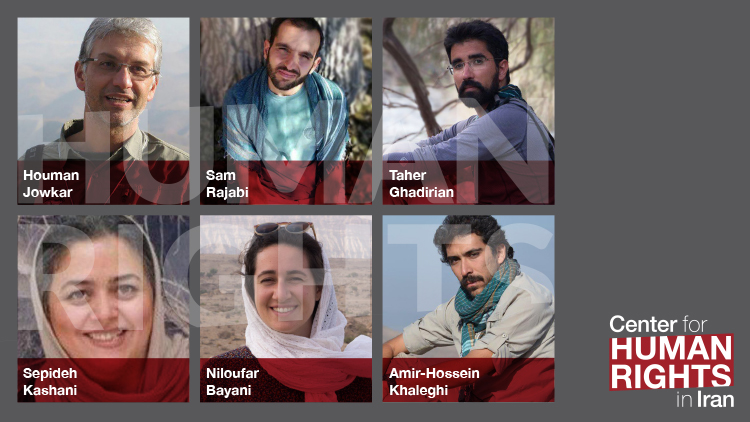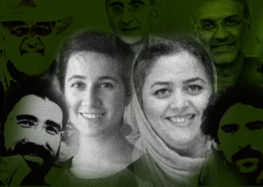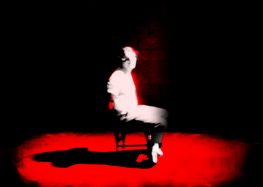Injuries Reported After Iran’s Detained Environmentalists Subjected to Renewed Interrogations
 Environmentalists detained without charge for the past five months in Tehran’s Evin Prison are once again being subjected to interrogations in the prison’s Ward 2-A under the control of the Islamic Revolutionary Guard Corps (IRGC).
Environmentalists detained without charge for the past five months in Tehran’s Evin Prison are once again being subjected to interrogations in the prison’s Ward 2-A under the control of the Islamic Revolutionary Guard Corps (IRGC).
“Sam Rajabi’s nose has been injured and Taher Bagherian’s front teeth have been broken and Niloufar Bayani was brought blindfolded to a meeting with her family by an agent who told her mother that Niloufar should cooperate [with her interrogators],” a source close to the detainees’ families told the Center for Human Rights in Iran (CHRI) on June 26, 2018.
The three are among several current and former staff members of the Persian Heritage Wildlife Foundation (PHWF), a non-governmental charitable organization based in Iran, that were arrested by the IRGC during a crackdown on environmentalists that began in late January 2018.
One of the detainees, Iranian Canadian PHWF managing director Kavous Seyed-Emami died in Evin Prison on February 9 and his family has since been repeatedly interrogated and harassed, with his widow banned from leaving the country.
“The interrogations inside prison have started again and they are under pressure,” said the source who requested anonymity for the security of the detainees. “This is very terrifying for the families. Why are the detainees being interrogated again after five months?”
According to Rajabi’s mother, the detained environmentalist is still being denied access to legal counsel.
“The lawyers have not been given permission to see him or study his case file,” Lili Houshmand Afshar told CHRI on June 26. “We don’t know what’s going on exactly. Some say the interrogations have ended and the case is in the hands of the prosecutor and some say the interrogations have resumed. No one gives us a straight answer.”
“The case investigator told me that Sam and the others have been charged with spying for Israel but this a completely false accusation,” she said.
Afshar added that when she visited her son on June 26, she noticed an injury on his nose.
“These prison visitations take place in the presence of an agent and we are not allowed to say anything other than hello, how are you,” she said. “So I don’t know what caused this injury.”
Afshar continued, “After five months of detention you can’t expect much about his condition. He’s weak, thin and pale. He had been in solitary confinement [from January 24] until March 18th.”
In addition to Rajabi, Bagherian and Bayani, the PHWF members arrested in January include Morad Tahbaz (also holds American citizenship), Amir Hossein Khaleghi, Taher Ghadirian, Houman Jowkar and Sepideh Kashani.
The IRGC also arrested more than 40 environmentalists, rangers and some of their relatives in early May in the southern Iranian harbor city of Bandar Lengeh and surrounding towns Lavaredin, Janah and Bastak in Hormozgan Province. They were working on a PHWF-sponsored regional wildlife project to protect local populations of ram and wild sheep.
Iran’s Intelligence Ministry, which operates under President Hassan Rouhani, has disputed the IRGC’s claim that the environmentalists engaged in espionage.
“It has been determined that these individuals were detained without doing anything,” said Vice President Isa Kalantari, the head of Iran’s Department of Environment (DOE), on May 22. “The Intelligence Ministry has concluded that there is no evidence that these individuals were spies.”
“The government’s fact-finding committee has concluded that the detained activists should be released because there’s no evidence to prove the accusations leveled against these individuals,” he added.
Earlier on May 9, Member of Parliament Mahmoud Sadeghi tweeted, “In yesterday’s meeting of the parliamentary committee on national security and foreign affairs, in response to questions to the intelligence minister about the reasons for the crackdown on environmental activists, the intelligence ministry’s counter-intelligence experts responded that they had found no evidence at all of their ties to espionage.”
According to the opposition news site Kalame, the environmentalists were targeted by the IRGC for opposing the installation of missile sites on protected lands.
“Kalame has received information that the environmental activists are not spies but in fact had resisted the IRGC’s excessive demands to encroach on environmentally protected regions for the installation of missile sites,” Kalame reported on April 16.
The report continued: “Although these regions were registered in the United Nations as protected areas, the IRGC thought it could build military sites there without any problem, thus it went ahead with installing missile silos and equipment. The move met opposition from environmental groups that repeatedly asked the IRGC to evacuate. The groups made it clear that the IRGC was endangering their activities to collect information and take photos of animals and plants for the UN. But the IRGC did not agree and asked these groups to instead submit old photos in their annual reports to the UN. The conflict between the two sides went on for years and eventually, the IRGC’s Intelligence Organization used espionage as an excuse to arrest the environmentalists so that it could continue its activities in the protected regions without any problem.”






